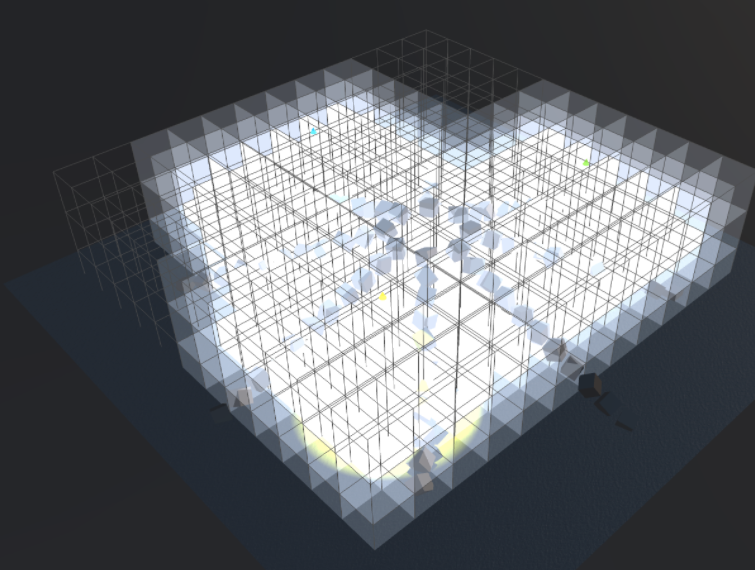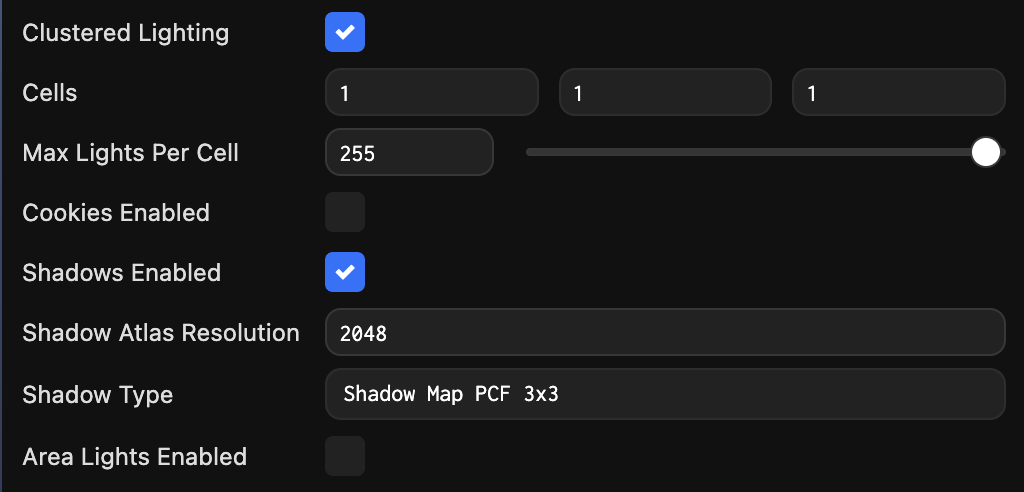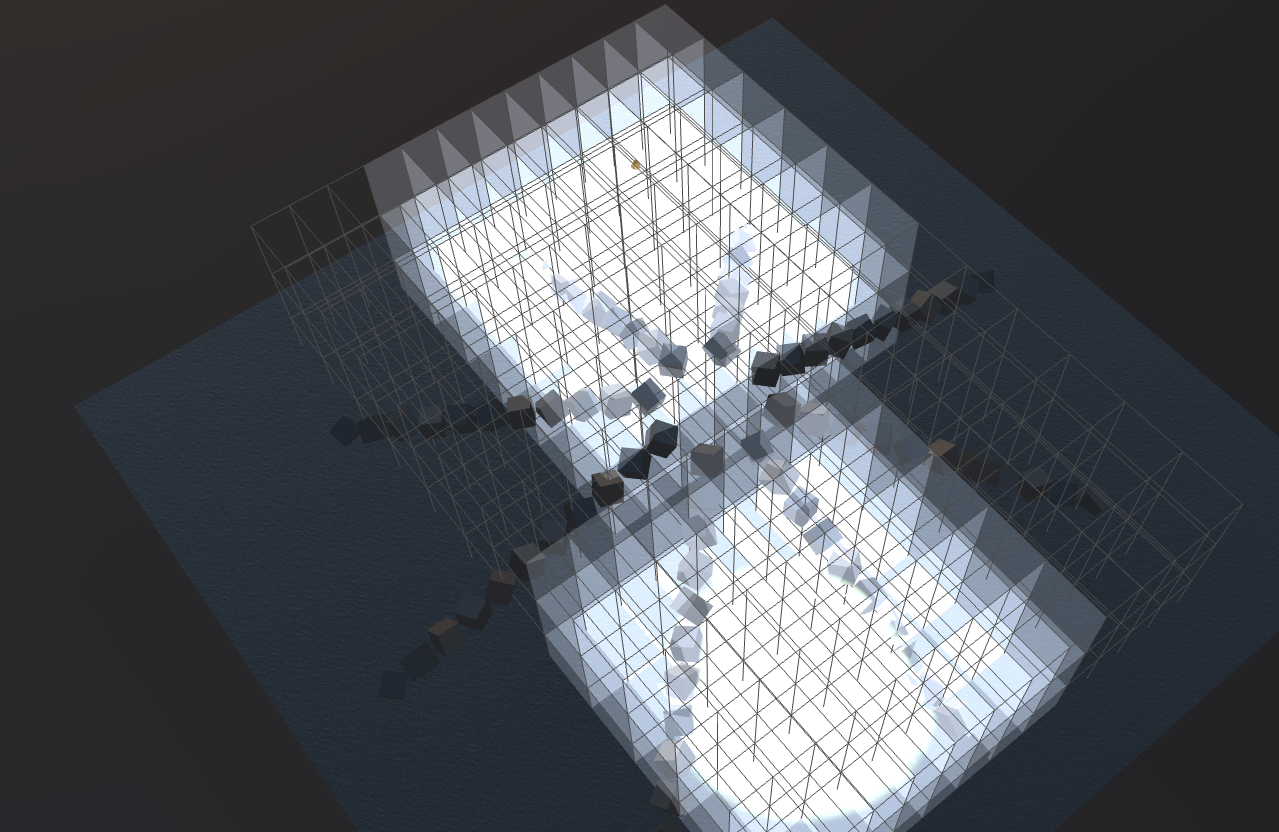클러스터드 조명 (Clustered Lighting)
조명은 애플리케이션에 사실감을 더하는 훌륭한 방법입니다. 하지만 실시간 조명은 특히 그림자를 캐스팅하는 많은 수의 조명이 있을 때 상당한 런타임 성능 비용을 발생시킬 수 있습니다.
성능 비용을 줄이는 해결책의 일부는 개별 메시에 영향을 미치는 조명의 양을 제한하는 것일 수 있습니다. 이는 종종 각 객체 근처의 조명을 찾아 사용하는 방식으로 구현됩니다. 하지만 이 전략에는 여러 단점이 있습니다:
- 각 객체가 다른 조명 세트를 사용할 수 있기 때문에, 이를 처리하기 위해 커스텀 셰이더를 컴파일해야 합니다.
- 이 전략이 효과적이려면 큰 객체를 더 작은 객체로 분할해야 합니다.
- 많은 수의 그림자 캐스팅 조명은 셰이더가 그림자 맵에 사용되는 사용 가능한 텍스처 슬롯을 모두 사용하게 할 수 있습니다.
이러한 문제를 해결하기 위해 OasisW는 클러스터드 조명 솔루션을 사용하여 전방향 조명과 스팟 조명의 성능 최적화 구현을 제공합니다. 이는 조명에 대한 정보를 텍스처에 저장하고 GPU가 음영 처리된 프래그먼트 근처의 조명만 쉽게 사용할 수 있게 합니다. 클러스터드 조명에는 여러 장점이 있습니다:
- 셰이더가 여러 조명을 처리할 수 있기 때문에 씬에서 조명이 추가되거나 제거될 때 셰이더를 재컴파일할 필요가 없습니다.
- 각 픽셀 근처의 조명만 평가되기 때문에 씬에서 많은 수의 조명(그림자와 쿠키 포함)을 사용할 수 있습니다.
방향성 조명은 모든 객체에 영향을 미치므로 클러스터드 조명 솔루션을 사용하지 않습니다.
구현 개요
다음 단계는 클러스터드 조명 구현의 기본 개요를 제공합니다:
-
프레임에 대해 보이는 조명 목록을 평가하기 위해 카메라의 모든 프러스텀으로 조명을 컬링합니다.
-
모든 보이는 조명의 축 정렬 경계 위에 월드 공간 3D 그리드를 배치합니다.

-
3D 그리드의 각 셀은 교차하는 조명 인덱스를 저장합니다. CPU에서 이 정보는 매 프레임마다 업데이트되며 모든 위치에 영향을 미치는 조명 목록을 가져올 수 있습니다. 이 정보는 텍스처에 저장되고 GPU에서 사용할 수 있게 됩니다.
-
모든 보이는 조명의 속성은 다른 텍스처에 저장되므로 GPU에서도 접근할 수 있습니다.
-
그림자 맵과 쿠키 텍스처는 개별 텍스처 대신 아틀라스로 렌더링되므로 셰이더에서 동시에 모든 것에 접근할 수 있습니다.
-
프래그먼트 셰이더에서 조명 평가 중에 프래그먼트 월드 공간 위치를 사용하여 3D 그리드의 셀에 접근하고 저장된 조명을 평가합니다.
에디터 옵션
클러스터드 조명 옵션은 'Rendering' 아래의 에디터 설정에서 찾을 수 있습니다.

이를 통해 클러스터드 조명을 비활성화할 수 있습니다(이전 조명 시스템을 사용해야 하는 경우). 또한 아래에서 언급된 성능 및 기능 조정도 가능합니다.
클러스터드 조명 조정
기능 활성화
클러스터드 조명 셰이더는 지원되는 모든 조명을 처리해야 하므로 이러한 기능을 처리하는 코드를 포함해야 합니다. 이로 인해 셰이더가 필요보다 커지고 컴파일 시간이 더 오래 걸릴 수 있습니다. 이러한 문제를 해결하기 위해 애플리케이션에서 필요하지 않은 기능을 비활성화하고 셰이더 컴파일 속도를 높일 수 있는 기능 옵션 세트가 있습니다:
- Shadows Enabled – 그림자 지원 활성화 또는 비활성화
- Cookies Enabled – 조명 쿠키 지원 활성화 또는 비활성화
- Area Lights Enables – 영역 조명 지원 활성화 또는 비활성화
3D 그리드 구성

Cells 속성을 사용하면 각 월드 축을 따라 셀의 수를 지정할 수 있습니다. 이는 모든 보이는 조명을 포함하는 축 정렬 경계 상자를 지정된 수의 셀로 동적으로 세분화합니다.
Max Lights Per Cell 속성을 사용하면 각 개별 셀에 저장되는 최대 조명 수를 지정할 수 있습니다. 이는 겹치는 최대 조명 수를 나타냅니다. 일반적으로 조명 겹침이 더 크기 때문에 더 거친 그리드 세분화의 경우 조명 수를 증가시켜야 합니다.
제한사항
내부적으로 조명 인덱스는 8비트를 사용하여 저장되므로, 모든 프레임에서 보이는 조명의 최대 수는 254개입니다(하나의 인덱스는 예약됨). 향후 16비트를 사용하여 인덱스를 저장하고 제한을 증가시키는 추가 옵션이 있을 수 있습니다.
성능 고려사항
- 셀 세분화는 가능한 한 작아야 합니다. 큰 셀 세분화는 매 프레임마다 그리드가 조명으로 채워질 때 더 큰 CPU 사용량을 초래하기 때문입니다. 이는 조명 복잡도에 따라 각 씬에 대해 최적화되어야 합니다. 최적으로는 조명의 겹침과 각 셀의 조명 수를 제한할 수 있을 만큼 충분한 셀이 있어야 합니다.
- Max Lights Per Cell은 가능한 한 작아야 합니다. 이는 매 프레임마다 업데이트되어야 하는 3D 그리드를 저장하는 데 사용되는 텍스처의 크기를 제한하기 때문입니다.
- 클러스터드 조명을 사용하는 애플리케이션이 오래된 모바일 기기에서 느리게 실행된다면, 그림자나 쿠키와 같은 기능을 전역적으로 끄는 것을 고려하세요.
디버그 그리드 렌더링
클러스터드 조명의 디버깅과 성능 조정을 돕기 위해 Layer ID를 LightingParams의 debugLayer에 할당할 수 있습니다. 예:
// 스크립트 타입에 있다고 가정
this.app.scene.lighting.debugLayer = this.app.scene.layers.getLayerByName("World").id;
렌더링을 중지하려면 debugLayer 속성에 undefined를 할당하세요:
// 스크립트 타입에 있다고 가정
this.app.scene.lighting.debugLayer = undefined;